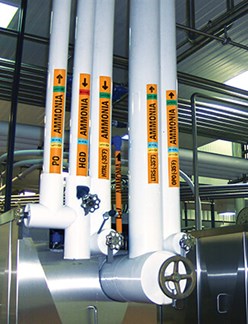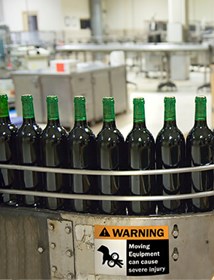Resource Navigation
Winery Safety: Common Violations and How to Stay Safe
03
February,
2023
3 MINUTE READ

Many of us romanticize the image of a wine maker caring for the vines, tending the fresh earth, hosting tastings paired with farm-fresh cuisine, and hand-applying artful labels. Yet as the wine industry grows that romantic notion fades once the reality of the job hazards involved are clear.
OSHA inspectors issued 87 citations to domestic wine producers in 2015, down nearly 70% from 280 violations in 2012. While winemakers and their employers clearly take safety seriously, dangerous work remains to be done. Here are two common citations issued to wineries-and how vintners can ensure safety for employees and visitors alike.
Pipe Marking Violations

Key to winemaking is that the liquid temperature must be carefully managed during the fermentation and storage phases of the wine-making process. Glycol chillers, ammonia refrigeration, and water cooling systems all contribute to this temperature control, and each may require networks of pipes to operate safely.
To that end, it's important to understand ANSI/ASME A13.1 so it is instantly recognizable which liquid, chemical, or gas flows through each pipe. However, OSHA does not specifically address pipe marking requirements; however, it references the ANSI/ASME standard, making it in effect OSHA's preferred pipe labeling system.
Understanding the color code at the heart of the standard, as well as best practices for label positioning and proper application, can help employees stay safe on the job-and provide vital information to first responders in case of emergency.
Ammonia pipe marking carries with it a different set of regulations and best practices; it follows the International Institute of Ammonia Refrigeration (IIAR) Bulletin No. 114, to be exact. Learn more about ammonia refrigeration fundamentals, and grab an ammonia pipe marking chart, produced by Duralabel.
Catch up on standards, best practices, and more with Duralabel pipe marking resource center. The resource includes articles, tutorials, how-to videos, our Best Practice Guide to Pipe Marking, and more-all designed to help employers implement proper pipe marking in their facility.
Confined Spaces
Over the years, numerous winery workers have been killed either transferring wine or cleaning tanks when carbon dioxide or carbon monoxide wasn't thoroughly removed from the confined space. (Confined space safety is paramount in another beverage industry that relies on tanks for fermentation and storage: breweries.)
In one such instance, a Napa winemaker died from asphyxia after falling into a wine tank while transferring red wine from a small portable tank to a larger tank. In another instance, a winery worker in Fresno, California, collapsed and died from asphyxia after another employee opened the wrong valve and released ammonia into a confined area. It takes only seconds for asphyxia to occur-a condition when the body is deprived of oxygen, causing unconsciousness or death. Choking or the inhalation of a high amount of ammonia, carbon dioxide or carbon monoxide will cause asphyxia.
Oregon OSHA posted a Hazard Alert (PDF) in early 2014 focusing on confined space entries at wineries within the well-known pinot growing state. Workers who clean, empty tanks, or check the fermentation process "are sometimes directed to bodily enter a tank or place their head inside a tank. The air inside a tank or vat may not be sufficient to support life when gases such as carbon monoxide or carbon dioxide have displaced oxygen. If the air is not tested prior to exposure, the result can be deadly," it states.
The Oregon hazard alert discusses the requirements to perform atmospheric testing before entering confined spaces of tanks in wineries. Winery tanks, in general, require confined space permits. These permits are intended to require employers at wineries to:
- Evaluate the work environment of confined spaces
- Identify hazards and label danger or warnings
- Develop written procedures to protect employees from those hazards
- Train employees in the procedures established
Duralabel free Best Practice Guide to Confined Spaces breaks down the dangers of confined spaces and outlines a path to ensuring safety in dangerous work environments. The guide identifies hazards, summarizes important OSHA regulations, and assists employers in developing processes to prevent injuries and fatalities.
Solutions for Safer Wineries

Duralabel provides numerous resources to help wineries promote a safer workplace. Visual communication, especially, can help employees stay safe around confined spaces and throughout wineries.
- Visual communication, in all its forms, is an essential component of a safe workplace. Learn more about printers, supplies, and accessories from Duralabel for creating customized safety signs, or check out our selection of premade signs and labels, available in various sizes and materials.
- Improve wayfinding throughout wineries, increase signage visibility in low-light situations, and make it easier for employees to load and unload shipments with DuraLabel Prismatic Reflective Tape. Available in vibrant colors, the durable reflective tape produces a superior reflection during power outages, after dark, or in other low-light settings.
RELATED RESOURCES

Tunnel Construction Safety
I'm in awe of tunnels. How do they construct giant tubes under mountains, lakes, rivers and oceans? How long ...
Read
Brewery Safety: Common Violations and How to Stay Safe
Beer has never been a bigger business in the United States than it is today. Roughly 4,000 U.S. breweries ...
Read
Safety Inspection vs Safety Audit
Safety Inspection vs Safety Audit There's no one "right" way to assess the effectiveness of workplace safety ...
Read.png)


